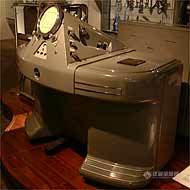-
+关注
私聊
-

天黑请闭眼
第33楼2009/05/29
A big disadvantage that no one has yet mentioned for TEM is that brehmsstrahlung x-rays are forward directed and can have the same energy as the beam electrons. Since TEMs are usually placed in rooms that are on the lowest floor, the conventional orientation causes most of the radiation to be directed harmlessly into the earth; whereas, an inverted orientation would direct them into the floor above. For lower voltage instruments, the intervening ceiling and floor might be enough to absorb the radiation, but for higher voltage instruments, there could be an unsafe level of radiation that makes it into the room above the scope. For the HVEM in Albany, NY, we were very concerned about radiation scattering in various directions, since a 1.2 MeV photon will traverse a few meters of lead.
是这段话么?那么岂不是做TEM的人一旦有阴极射线泄露,危险之至?
-
+关注
私聊
-

iamikaruk
第34楼2009/05/29
对,就是这个主题。前面有位老兄就说他了同事的事情
shxie 发表:A big disadvantage that no one has yet mentioned for TEM is that brehmsstrahlung x-rays are forward directed and can have the same energy as the beam electrons. Since TEMs are usually placed in rooms that are on the lowest floor, the conventional orientation causes most of the radiation to be directed harmlessly into the earth; whereas, an inverted orientation would direct them into the floor above. For lower voltage instruments, the intervening ceiling and floor might be enough to absorb the radiation, but for higher voltage instruments, there could be an unsafe level of radiation that makes it into the room above the scope. For the HVEM in Albany, NY, we were very concerned about radiation scattering in various directions, since a 1.2 MeV photon will traverse a few meters of lead.
是这段话么?那么岂不是做TEM的人一旦有阴极射线泄露,危险之至?
-
+关注
私聊
-

大陆
第36楼2009/05/29
卖东西的主很少有主动展示商品危害的。
CRT示波器,CRT显示器和电视机的电子加速电压少则几百伏,泄漏比TEM小得多,但都是对人体直射,辐射不会少。这可能是LCD能大行其道的另一个缘故吧。shxie 发表:A big disadvantage that no one has yet mentioned for TEM is that brehmsstrahlung x-rays are forward directed and can have the same energy as the beam electrons. Since TEMs are usually placed in rooms that are on the lowest floor, the conventional orientation causes most of the radiation to be directed harmlessly into the earth; whereas, an inverted orientation would direct them into the floor above. For lower voltage instruments, the intervening ceiling and floor might be enough to absorb the radiation, but for higher voltage instruments, there could be an unsafe level of radiation that makes it into the room above the scope. For the HVEM in Albany, NY, we were very concerned about radiation scattering in various directions, since a 1.2 MeV photon will traverse a few meters of lead.
是这段话么?那么岂不是做TEM的人一旦有阴极射线泄露,危险之至?
-
+关注
私聊
-

【四季风】
第37楼2009/05/29
浅谈电子显微镜发展的历史
发布: 2009-3-18 12:01 | 作者: bojue | 来源: 电镜之家
http://www.emroom.cn/space/?action-viewthread-tid-350
从最初的理论基础,历经中间的实验研制,到现在的产品成型,来说一说电子显微镜发展的历史。
一.理论基础:
1923年,法国物理学家德布罗意发现,微观粒子本身除具有粒子特性以外还具有波动性。他指出不仅光具有波粒二象性,一切电磁波和微观运动物质(电子、质子等)也都具有波粒二象性。电子在高速运动时,其波长远比光波要短得多,于是人们就想到是不是可以用电子束代替光波来实现成像?
1926年,德国物理学家H•Busch提出了关于电子在磁场中的运动理论。他指出:具有轴对称性的磁场对电子束来说起着透镜的作用。从理论上设想了可利用磁场作为电子透镜,达到使电子束会聚或发散的目的。
二.实验研制:
1932年,德国柏林工科大学高压实验室的M.Knoll和E.Ruska研制成功了第1台实验室电子显微镜,这是后来透射式电子显微镜的雏形。其加速电压为70kV,放大率仅12倍。尽管这样的放大率还微不足道,但它有力地证明了使用电子束和电磁透镜可形成与光学影像相似的电子影像。这为以后电子显微镜的制造研究和提高奠定了基础。
1933年,E.Ruska用电镜获得了金箔和纤维的1万倍的放大像。至此,电镜的放大率已超过了光镜,但是对显微镜有着决定意义的分辨率,这时还只刚刚达到光镜的水平。
1937年,柏林工业大学的Klaus和Mill继承了Ruska的工作,拍出了第1张细菌和胶体的照片,获得了25nm的分辨率,从而使电镜完成了超越光镜性能的这一丰功伟绩。
1939年,E.Ruska在德国的Siemens公同制成了分辨率优于10nm的第1台商品电镜。由于E•Ruska在电子光学和设计第1台透射电镜方面的开拓性工作被誉为“本世纪最重要的发现之一”,而荣获1986年诺贝尔物理学奖。
除Knoll、Ruska以外,同时其他一些实验室和公司也在研制电镜。如荷兰的菲利浦(Philip)公司、美国的无线电公司(RCA)、日本的日立公司等。
三.产品成型:
1944年,Philip公司设计了150kV的透射电镜,并首次引入中间镜。
1947年,法国设计出400kV的高压电镜。
60年代初,法国制造出1500kV的超高压电镜。
1970年法国、日本又分别制成3000kV的超高压电镜。
其实,进入60年代以来,随着电子技术的发展,特别是计算机科学的发展,透射电镜的性能和自动化程度有了很大提高。现代透射电镜(如日立公司的H-9000型)的晶格分辨率最高已达0.1nm,放大率达150万倍。人们借助于电镜不但能看到细胞内部的结构,还能观察生物大分子和原子的结构,应用也愈加广泛和深入。
扫描电镜作为商品出现则较晚,早在1935年,Kn- oll在设计透射电镜的同时,就提出了扫描电镜的原理及设计思想。1940年英国剑桥大学首次试制成功扫描电镜。但由于分辨率很差、照相时间过长,因此没有立即进入实用阶段,至1965年英国剑桥科学仪器有限公司开始生产商品扫描电镜。80年代后扫描电镜的制造技术和成像性能提高很快,目前高分辨型扫描电镜(如日立公司的S-5000型)使用冷场发射电子枪,分辨率已达0.6nm,放大率达80万倍。
